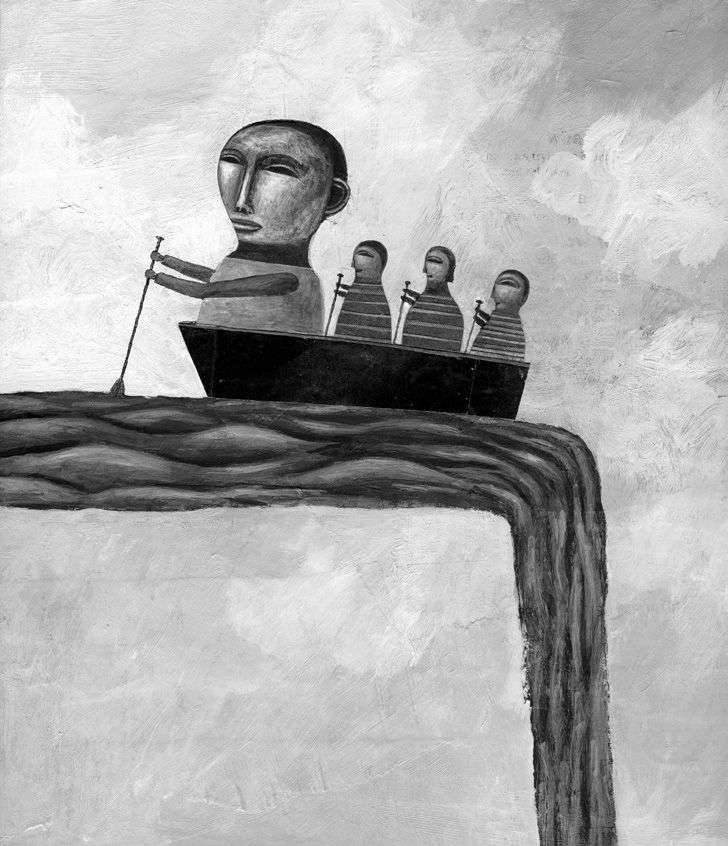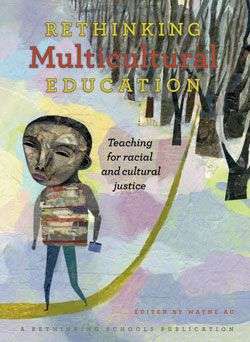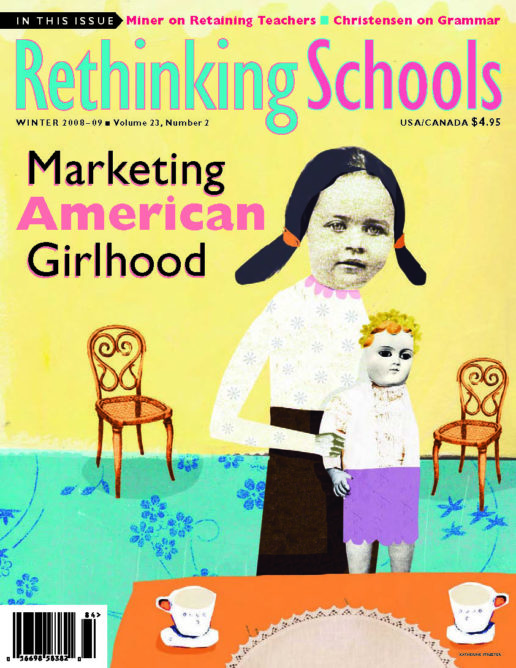Decolonizing the Classroom: Lessons in Multicultural Education
Illustrator: Jordin Isip

When I was in 9th grade, I had Mr. Anderson for honors World History. Mr. Anderson was one of those teachers that all the honors and AP-track parents wanted their kids to have. He had a reputation for academic rigor, of preparing teenagers for their stratospheric climb towards being a National Merit Scholar slated to attend an Ivy League college.
Like many history teachers, Mr. Anderson talked about his trips to places we studied. During our unit on China, I remember him telling us stories about his trip there, including the exciting fruit he ate, something he called “lee-chee.”
I knew what he was talking about. I loved lychee. Available only about six weeks a year and costing up to $8 a pound, lychees were a rare treat in my family. After my parents divorced, my father would take me to San Francisco’s Chinatown during summer visits, where we bought bunches of the syrupy sweet fruit with translucent flesh. Sitting in the park, cracking the lychee’s rough, deep red skin and feeling its juices drip down our chins and fingers, my father told me stories of his childhood in Hawaii, about how he would sneak into the lychee groves to get the precious fruit at the risk of getting shot by farmers guarding their crops.
But in my family, we said it differently. We called it “LIE-chee.” Knowing that the translation between Chinese and English is difficult and imprecise, I raised my hand and tried to tell Mr. Anderson how my family pronounced it. He wasn’t having it. This white teacher had been to China and knew better. So he told me (and the class) that I was simply wrong, that I didn’t know what I was talking about. Never mind my memories of lychee, never mind my father’s stories, and never mind that my Chinese grandmother, aunts, uncles, and cousins all pronounced it LIE-chee.
Now that I have been both a high school teacher and a teacher of teachers, when I reflect back on his class, I see that Mr. Anderson taught us some basic lessons about multicultural education, albeit by negative example. For instance, in Mr. Anderson’s class, student knowledge about communities, cultures, and diversity didn’t matter, especially if it contradicted his own. Further, Mr. Anderson’s contempt for student knowledge revealed no sense of curiosity about the experiences and stories that might lead to a different perspective than his.
Another related lesson to take away from Mr. Anderson’s negative example is that multicultural education should seek to draw on the knowledge, perspectives, and voices of the actual communities being studied. In Mr. Anderson’s class, my own authentic cultural knowledge and perspective as a Chinese American had no value, and he actively disregarded my own lived experiences. Again, Mr. Anderson was contemptuous of student knowledge and he disregarded the importance of building from kids’ lives and prior experiences.
Mr. Anderson’s example also teaches us that, because it is connected to students’ lives, multicultural education has to be based on dialogue — both amongst students and between students and teachers. As students in Mr. Anderson’s class we were always on the outside looking in, and he and the textbooks were the sole authorities. There was no dialogue, only monologue.
The final lesson to draw from Mr. Anderson is that, when classes are not grounded in the lives of students, do not include the voices and knowledge of communities being studied, and are not based in dialogue, they create environments where not only are white students miseducated, but students of color feel as if their very identities are under attack.
Multicultural Education on the Down Low
I had to get my real multicultural education on the down low, outside of classes like Mr. Anderson’s. I went to Garfield High School, located in Seattle’s historically African American neighborhood, the Central District. Garfield has been known for many years as Seattle’s “black high school,” and back in the 1970s there was a strong Black Panther Party presence both in the neighborhood and in the school itself. Garfield, always a basketball powerhouse, also boasts a rich connection to African American culture and music, with names like Quincy Jones and Jimi Hendrix still haunting the hallways.
By the time I got there in the late 1980s, Garfield had become a flagship for the Seattle Public Schools. It housed the district’s AP program, maintained a world-renowned jazz band, was the district’s science magnet high school, and provided a model of Seattle’s desegregation busing system (of which I was a part). Totaling around 1,600 students, Garfield’s student body hovered at about 50 percent African American and 50 percent white, with a few Latinos and Asian Americans like myself sprinkled in.
Given Garfield’s history, position in the community, and commitment to racially integrated education, you might think that real multicultural education took place in most classes. Sadly, it didn’t. There was one teacher, Mr. Davis, who taught two “secret” classes at my school: one section of Harlem Renaissance and one section of African Studies.
To get into Mr. Davis’ classes, you first had to learn (by word of mouth) the true content of his classes, which were listed plainly in the schedule as Language Arts 10b and Social Studies elective. Second you had to convince your counselor that yes, you really did want to be in Mr. Davis’ class, that yes, you really knew what you were getting into.
For the first time in my schooling experience, I was one of only two non-African American students in a class. In Mr. Davis’ classes we looked at the politics of Blackness through the poetry and literature of the Harlem Renaissance and hashed through segregation, desegregation, and African American identity in U.S. history. We read about how Greek civilization was built upon a legacy of knowledge that had already existed in Egypt. And then we learned that Egypt wasn’t really “Egypt.” From an African-centric standpoint it was actually called Kemet, with its own rich cultural worldview, symbolism, and creation stories.
I sat in this decidedly African-centric, predominantly African American cultural space, trying to sort through my own cultural identity as a mixed white and Chinese American young man, my own connection with African American culture, and my own sense of education and the politics of race. And I’m sure my presence also left many of my African American classmates questioning. I mean, what was this half-Asian kid doing in the black studies classes anyway? Why does he care? Isn’t race and racism mainly about black and white? Do Chinese Americans, let alone half-bloods, even count as people of color? Struggling with these questions (and many more), all of us were asked to stretch.
To be sure, an African-centric course cannot be “multicultural” in and of itself. African-centered is just that, African-centered. But in the real-life context of a school like Garfield, Mr. Davis’ classes embodied multicultural education: it was grounded in the lives, identities, and histories of students; it provided critical and alternative perspectives on history that we were not getting in our other classes; and it openly addressed the issue of racism.
Years later, having worked with very diverse populations of students, I see that Mr. Davis’ classes also taught me about multicultural education. For instance, his class illustrated how multicultural education is fundamentally based in a critique of school knowledge that has historically been Eurocentric. For example, it was in his class that we learned that “civilization” did not start in Europe, that other nations and cultures had great civilizations that pre-dated their Western counterparts. Challenging such Eurocentrism also spoke to the cultural and political imperative to resist Eurocentric curriculum, as Mr. Davis saw his course as a positive and supportive intervention in the identity development and self-esteem for the students in his classes. Finally, inherent in Mr. Davis’ instruction is the lesson that it is important to critically question what textbooks and teachers say about the world.
Mr. Davis’ classes also offered a lesson on how multicultural education invites students to engage with real social issues. In his courses my classmates and I connected our burgeoning historical understandings of race and racism to contemporary issues. We argued about interracial dating, black nationalism, racism, and education. In this way, multicultural education inherently connects learning to the world outside of our classrooms.
Another lesson to be gained from Mr. Davis’ example is that multicultural education creates a space for students to meaningfully engage with each other. It was through such struggle over social and political issues that I developed substantive relationships with my African American classmates — relationships that I do not think could have developed in my other, more Eurocentric classes that were either populated predominantly by white kids or simply did not create the space to really engage students of color.
Finally, it is crucial to acknowledge that Mr. Davis’ classes helped me learn that multicultural education is rigorous. In African Studies and Harlem Renaissance we read serious texts like George G.M. James’ Stolen Legacy to learn about ancient Egypt’s effect on ancient Greek civilization, or Joel Augustus Rogers’ From Superman to Man to gain historical perspectives of U.S. race relations.
Rigor and Multicultural Education
The connection between multicultural education and rigor is important because one of the consistent critiques of multicultural education is that it isn’t “real” education, that it isn’t rigorous. However, the idea that multicultural education represents a lowering of standards or a neglect of academic rigor is false.
Let’s compare Mr. Davis’ and Mr. Anderson’s classes. As with most “rigorous,” upper-track classes, the central pieces of rigor I remember from Mr. Anderson’s “honors” World History class consisted of an immense amount of textbook reading, chapter questions, and a research paper. Such courses are rigorous in particular ways. Certainly they have formal and strict requirements, and Mr. Anderson’s class, like most others of its kind, was demanding in terms of workload. We were always kept busy.
Now as a professor of education, when I critically reflect on these types of “honors” or “advanced” classes, I think that, although they require significant amounts of work, they are not necessarily intellectually rigorous. Instead they often ask for memorization and textbook reading comprehension, not critical analysis. Knowledge is multifaceted and simply reading tough books does not mean that students are engaged in understanding the complexities of any particular historical episode or time period.
Take teaching about the U.S. war with Mexico, for instance. A typical class would focus solely on the actions of governments — U.S. and Mexican alike. A multicultural perspective asks about the Irish-American soldiers, Mexican women in conquered territories, black and white abolitionists who opposed the war, soldiers who embraced and also rejected the war, Mexican cadets who jumped to their death rather than surrender to invading U.S. troops, etc. A multicultural perspective is not only inherently more interesting, it is also more complex — and more fully truthful, if we dare use that word. Further, academic rigor is impossible without the multiple perspectives that multicultural education provides because without it, we miss huge pieces of history, culture, and society — leaving gaps in our knowledge about the world.
Mr. Anderson’s class miseducated us about the world, too. For instance, in addition to the textbook readings for our unit on Africa, Mr. Anderson had us watch the movie, The Gods Must Be Crazy. In this movie an African San is befuddled by Western technology and makes a buffoon of himself. Through my 9th-grade eyes, I saw the colonizers’ view of the African-native-as-primitive, of darker peoples as idiotic and childlike.
Mr. Anderson didn’t really teach about this film. He just showed it as an “entertaining” way for 14-year-olds to learn about Africa. So we never learned about how such a film could justify the system of apartheid in South Africa by portraying the San people as incompetent and unable to be incorporated into a democratic society. We never learned how such a film might rationalize the idea that the San needed “benevolent” white rulers to take care of them.
My African Studies course with Mr. Davis, however, was different, and despite its tag as being “regular,” its perspective made it more intellectually rigorous than my “honors” history classes because, as all good multicultural education should do, we were asked to consider the variety of our own experiences and relate them to the complexities of history and society.
I remember struggling to write a paper for Mr. Davis that explained the relationship between race, poverty, and education in the United States. While in many ways this topic was probably beyond my mid-teen reach, in many ways it wasn’t: The relationship between race, poverty, and education was something I was trying to understand (and still am), and writing a paper about it pushed me in my writing and my thinking. Assignments like this made me think hard in my “regular” African Studies class, whereas my “honors” World History class asked for very little thinking at all — just lots of work. More importantly, this assignment illustrates how a multicultural curriculum honors the experiences and curiosity of students so that their own questions about these issues are encouraged and honored as a way of fueling their academic inquiry.
This rigorous need for multicultural perspectives raises another critical lesson: Multicultural education cannot be relegated to individual classes. Mr. Davis’ classes were important because they existed within a context where most other classes were Eurocentric, so they became spaces of multicultural resistance. But ideally all classes at Garfield — social studies, language arts, math, science, art, etc. — should have taken multicultural education seriously if they really wanted to be rigorous and if they really wanted to engage all students in learning. For that matter, all classes for all students, from prekindergarten on, should take multicultural education seriously. Then, students would generally be in a position to more actively and collectively resist classroom colonization and would be smarter in that they could take up a more critical analysis of all course content.
The Struggle for Multicultural Education
Sadly, college-bound students at Garfield certainly didn’t fight to get Mr. Davis’ classes on their transcripts. Instead they would forego Harlem Renaissance and African Studies in order to stay in AP and on the honors track. Things haven’t changed all that much since I was in high school, because in today’s context of high-stakes education, multicultural education is still viewed as not academically rigorous, not “real” education, and not worthy of being included in the curriculum in its own right.
The lowly status of multicultural curriculum has also meant a constant fight to justify its existence. Take again for instance the African Studies class at Garfield. Ten years after I had walked the halls as a student, I returned to Garfield as a teacher. To my great pleasure, African Studies was given to me as part of my teaching load.
Not surprisingly, I found that many teachers in the social studies department openly sneered at the African Studies course, and the department chair — seeing that Mr. Davis had left to become a principal — thought it would be a good chance to get rid of the class. In his mind, it had no value. What the department chair couldn’t see, and what I knew as a legacy student of that very same class, was that African Studies created an irreplaceable space to engage in the politics of Blackness that existed nowhere else at Garfield. Further, African Studies was an irreplaceable space where students’ cultures were respected, where students learned to think in terms of multiple social experiences, where traditional narratives and explanations were complicated by race and culture. After a protracted and sometimes nasty fight, the African Studies course survived (and I enjoyed teaching it), but there shouldn’t have been a fight to begin with. My experience fighting for African Studies taught me another lesson: Multicultural education is rooted in an anti-racist struggle over whose knowledge and experiences should be included in the curriculum.
The Need for Multicultural Education
I think the biggest lesson in multicultural education I’ve learned from my experiences as a student, teacher, and teacher educator, is that it is a valuable and necessary orientation towards teaching and learning that needs to be embraced by all educators. Every institution I’ve ever worked in has been resistant to multicultural education in some way, shape or form, and I’m tired of having to justify it, tired of having to prove its worth. As a person of color I take offense at the idea that my history, my perspective on the world as an individual and a representative member of a community does not matter.
As a teacher educator I encounter on a daily basis the consequences of schooling that is not multicultural. Many of my students know little of the histories and cultures of the students whom they will end up teaching. What’s more, they don’t know that they don’t know, and I fear that many of them will enter communities of color as an army of Mr. Andersons, damaging the young people they’re trusted to educate. Hopefully, the lessons in multicultural education they learn in my classes will help them become more like Mr. Davis, teachers who can lead a struggle against racism in their classrooms.


